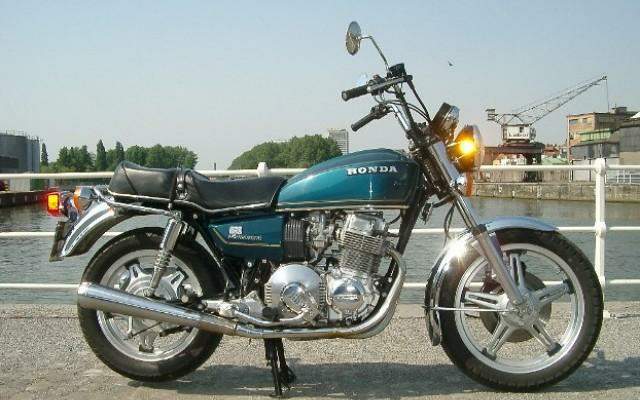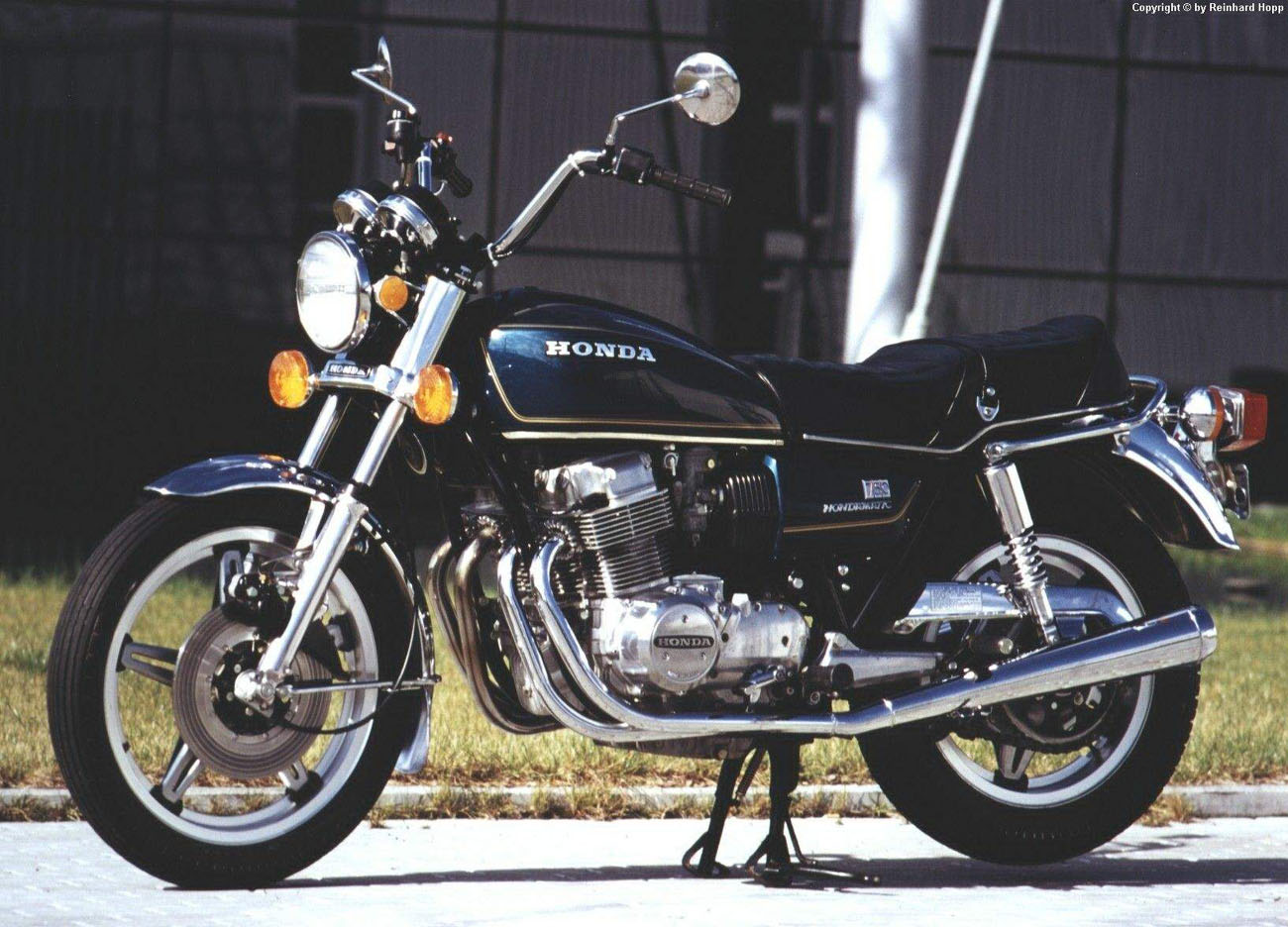At the start of 1977, Honda was producing two motorcycles models that were equipped with automatic transmissions. The CB400A, known in the USA as the Hawk, and the CB750A, a reworking of the CB750F model available at the time. These bikes were initially conceived as a way for learner riders to get used to riding motorcycles, without the fear of stalling. This allowed for the novice to practice staying upright, braking and riding in traffic, all without having to focus on changing gears constantly as well.
I say changing gears constantly , because the automatic transmissions offered on Honda motorcycles were not automatic in the true sense of the word. A shift lever (in the same position as a gear changer) on a manual Honda, allowed the rider to shift between neutral, low and drive. The ability to manually shift between high and low made sure the bike wouldnít shift gears through a corner, throwing any novice rider off balance. Also built into the automatic models was a linkage from the kickstand to the gear lever, so when the kickstand was operated, the bike would put itself back into neutral. This would stop the bike from starting while in gear, something someone new to riding might overlook after getting back on the back. Nifty little tricks like these helped Honda to aim these new motorbike riders, to protect them from themselves.
On the downside, the automatic bikes lacked the performance of their manual brothers. Quarter mile times and top speeds were slower, the added weight of the transmissions not helping. The CB750A didnít allow enough acceleration on the downshift to pass cars, the CB400A transmission allowed too much chance of over run when heading into corners at speed. Performance issues, and a change in the demographic of bike buyers at the time made sure the Hondamatics only got a three year run before being dropped from the lineup.
In an engineering sense, the CB750A wasnít just a CB750 with an automatic transmission fitted. Much work went into this model to make them stand apart from their CB750 stablemates. The engine gained different rocker covers and crankcases to suit the different engine/ transmission combo. The engines were changed from dry sump to wet sump, the same oil going from the torque convertor, through the engine to be cooled. The torque convertor is of the same design as the Civic cars of the time, as well as the Moto Guzzi V1000 which would have been a competitor to the CB750A. A three part unit, the convertor was made up of a centrifugal oil pump, a turbine wheel and a stator. The oil pump, driven off a primary drive connected to the crank, would spin inside the turbine wheel, both of these components being bowl shaped. The oil from the pump would travel along the vanes of the turbine wheel, where it is then directed to the cup shaped vanes of the stator wheels, and deflected back to the oil pump hub. A simple but rugged idea, with the Hondamatic motorcycles gaining a name for reliability which still stands today.
In regards to the fuel system, the standard CB750 fare was not going to suit the Hondamatic. Four 24mm slide/needle Keihin carbs are fitted, along with an accelerator pump so when the bike is accelerated from idle it does not suffer from the ĎHonda Burpí of the period. On top of this an electronically controlled diaphragm on the throttle linkage automatically bumps up the revs as soon as the transmission is engaged, to make sure the bike doesnít stall. Breathing out is taken care of by a 4 into 2 exhaust system, the silencers swept up and back in the Ďcustomí style of the time.
Aesthetically the bike looks very different to the other CB750 models, the designers looking to the GL model Honda for inspiration. GL style rims are fitted front and reaf, a 19.5 litre GL styled tank is factory fitted, the handlebars high and wide. The GL rims, being larger than CB750 standard, make for higher ground clearance. On the other hand they make the bike look bulkier than it really is. Stopping duties are covered by standard Honda fare, disc in the front, drum in the rear. The front caliper is slightly different to standard CB spec, as the owner has found out whilst doing routine maintenance, and had to source the parts specific to his bike. A road test of the period rates the rear drum as adequate, and the front disc as Ďthough not being the best disc brake, but for the design of the bike it works wellí.
Instruments are basic, the tachometer making way for a large light readout showing whatever gear the bike is in at the time. The speedometer gives the range for both low and drive gear, so as to make sure the rider does not overwork the engine. Drive gear is good from 0 up to 100mph, the low gear being only from 0 to 60mph. Although it is possible to use high gear all the time, using low gear in traffic is the better option, and leave the drive gear for the open road.
To keep the spark in the plugs, the electrical system has been worked over also. A large 20 amp hour battery takes the traditional place of the Honda oil reservoir, being fed by a 290 watt alternator. Kickstart on this model is in case of emergency only, with a kickstart lever mounted under the seat in case of a flat battery. And even with all this additional engineering, on top of the great bike design that was the CB750, the CB750A couldnít keep itself viable in the market.

In early 1977 Bennett Honda, Australiaís Honda importer, brought in two California spec CB750A for evaluation in regards to selling them on the Australian market. These bikes were given to local motoring journalists, on the proviso that no one was to do a writeup on a roadtest for the bike. One magazine broke the pact, and wrote up their thoughts on the CB750A. This prompted Honda Australia, who had taken over from Bennett in importing bikes, to release the bikes for a second full roadtest. This time the journalists would be allowed to do a full review and publish their view of the bike. This was all for naught, as in the end Honda Japan decided that it would be a waste of money to specify such a small batch of bikes to sell on the Australian market, and the two test bikes were the only CB750A bikes brought into the country by Honda.
After Honda Australia gave up on the idea of importing CB750A bikes into the country, the test bikes were sold onto Jim Aireyís dealership in Sydney. One of the bikes was purchased by a local car dealer, who painted it white. It got stolen not long after and hasnít been seen since. The second test bike found itís way into the hands of the current owner, who after 35 years is still happy with the purchase. Modifications have been made over the years, an oil cooler fitted, lower handlebars for better riding position, the original exhaust pipes put away for safekeeping. The only other noticeable modification is the seat being retrimmed, but foam doesnít last forever and this bike has racked up some miles. The bike being California spec, the indicators and headlight come on as soon as the ignition is turned on, not something you normally find on bikes in Australia. The bike looks immaculate for all itís years, looking no worse than pictures of it taken for a magazine review in late 1977. This CB750A is definitely no trailer queen either, if it goes somewhere it is under itís own power, and the owner likes to take it out at least once a month to stretch itís two speed legs. This remnant, of an attempt to produce a whole new class of motorcycles is in good hands, the owner showing it is possible to have a rare bike and not have to hide it away in the garage under a cover.
Ultimately the automatic motorcycle craze did not take off. The CB750A was classed as too heavy for novice riders, and too slow for experienced riders. The bulk of the transmission worked against both class of riders, leaving the over engineered CB750A without a demographic to sell to, thus ending in itís demise in 1978. Popularity in these models are rising, with riders realising that these bikes arenít bad per se, itís just a different riding style is required. Plus the fact they are older bikes arenít a handicap that they are lacking in performance. A rare bike, with a good build quality, itís good that a CB750A has found itís way into the feature bike ownerís hands and that he is willing to show it off. Or to put it in Motorcycle Classics terms: To ride it, not hide it.
Thanks to the owner of the bike for his time and information. Also Tom Day and Stewart MacDonald for their assistance in researching this piece.
(As posted on Motorcycle Classics 07/02/2013)
Post Script: One thing I got wrong in this article when I first wrote it was that the CB750A used the same frame as the other CB750 models. In fact, it had a unique frame which alot of other CB750 parts would not fit on.
Source The Manifold

